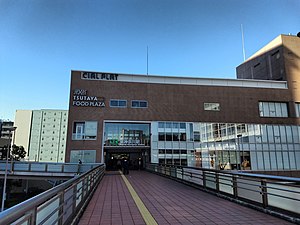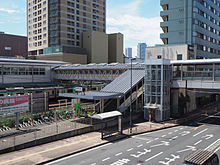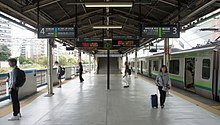Higashi-Kanagawa Railway Station
| Higashi-Kanagawa ( 東 神奈川 ) | |
|---|---|
|
East entrance (November 2018)
|
|
| Data | |
| Location in the network | Through station |
| Platform tracks | 4th |
| abbreviation | JK13 / JH13 |
| opening | September 23, 1908 |
| location | |
| City / municipality | Yokohama |
| prefecture | Kanagawa |
| Country | Japan |
| Coordinates | 35 ° 28 ′ 41 ″ N , 139 ° 38 ′ 0 ″ E |
| Height ( SO ) | 6 m TP |
| Railway lines | |
| List of train stations in Japan | |
The Higashi-Kanagawa Station ( Japanese 東 神奈川 駅 , Higashi-Kanagawa-eki ) is a train station on the Japanese island of Honshu . It is operated by the JR East Railway Company and is located in Kanagawa Prefecture in the Yokohama City area .
links
Higashi-Kanagawa is a separation station on the Keihin-Tōhoku Line from Tokyo to Yokohama . From this the Yokohama line branches off to Hachiōji . On both lines, JR East offers a dense regional service with train schedules of three to ten minutes. Almost all trains on the Yokohama Line are connected to the neighboring Yokohama Station. During the day, between 10:00 a.m. and 3:30 p.m., express trains run from Hachiōji via Higashi-Kanagawa and Yokohama to Sakuragichō . Regional and express trains of the Keihin-Tōhoku line are directed to the Negishi line in Yokohama , endpoints are Ōmiya and Ōfuna .
At the western exit of the train station, eight bus lines from the Yokohama City Transportation Office stop , and another one at the eastern exit. About 150 meters to the south-east is the Nakakido station on the Keikyū main line of the Keikyū railway company ; a pedestrian passage leads directly there.
description
The station is named after the district of Higashikanagawa, which belongs to the Kanagawa-ku district in the east of the city. It is oriented from northeast to southwest and has eight tracks, four of which are used for local passenger traffic. These are located on the east side on two covered central platforms . The parallel pairs of tracks of the Tōkaidō main line and the Shōnan-Shinjuku line on the west side have no platforms, so that their trains cannot stop here.
The station building has the shape of a riding station that spans the entire complex. Stairs , elevators and escalators lead down to the platforms. These in turn are connected to each other at their northern end by a covered pedestrian bridge. The six-storey shopping center CIAL PLAT , which opened in 2009, rises above the Osteinang . It has 19 stores and is operated by a subsidiary of JR East.
In the 2018 fiscal year, an average of 37,378 passengers used the station every day.
Tracks
| 1 | ■ Keihin-Tōhoku Line (southward) | Yokohama • Kannai • Ōfuna |
| 2 |
■ Keihin-Tōhoku Line (southward) ■ Yokohama Line (southward) |
Yokohama • Kannai • Ōfuna Yokohama |
| 2 • 3 | ■ Yokohama Line (northward) | Shin-Yokohama • Machida • Hashimoto • Hachiōji |
| 4th | ■ Keihin-Tōhoku Line (northward) | Shinagawa • Tokyo • Ueno • Ōmiya |
history
The private railway company Yokohama Tetsudō opened the station on September 23, 1908, together with the Yokohama line along its entire length to Hachiōji . Until 1928 there was a train station called Kanagawa a little further to the southwest , which is why the new one was given the suffix Higashi ("East"). The Yokohama Tetsudō , whose management was identical to that of the Yokohama warehouse company (Yokohama sōko) , had a wharf and warehouse built on newly raised land on Tokyo Bay . A freight connection line to Umikanagawa, which went into operation on December 10, 1911, was built to develop them. Already on 1 April 1910, the Yokohama Line was at the railway office (later Ministry of Railways ) leased been, now led by the entire rail traffic and the company on October 1, 1917 all took.
On December 20, 1914, the Railway Authority opened the Keihin-Tōhoku line , which replaced the local traffic of the Tōkaidō main line between Tokyo and Yokohama . However, only six days later, operations had to be temporarily suspended because the electrical systems were incorrectly constructed. The faults were finally resolved on May 10, 1915. On June 17, 1917, another connecting line to the Takashima freight yard was opened. On April 4, 1925, the Ministry of Railways electrified the Higashi-Kanagawa- Machida section of the Yokohama Line. Initially, this section was only used for testing purposes; Electric trains did not run according to the timetable until October 1, 1932. From the same day it was also possible to run trains on the Yokohama Line to Sakuragichō without changing trains .
During an area bombing by the United States Army Air Forces on Yokohama on May 29, 1945, the original station building burned down completely; a provisional solution took its place. The direct connection between the Yokohama Line and Sakuragichō remained interrupted until April 13, 1959. Due to a reorganization of the traffic flows in the port of Yokohama, the Japanese State Railways closed the branch lines to Umikanagawa and Takashima on April 1, 1959. In the following year, the present reception building was ready to move into. For cost reasons, the state railway stopped checking in luggage on February 1, 1984. As part of the privatization of the state railway, the station passed into the possession of the new company JR East on April 1, 1987 . Platforms 1 and 4 were fitted with platform screen doors on December 27, 2018 .
Adjacent train stations
|
←
|
Lines |
→
|
||
|---|---|---|---|---|
| Shin-Koyasu |
JR East |
Yokohama | ||
| Yokohama |
JR East |
Ōguchi | ||
Web links
- JR East Station Information (Japanese)
Individual evidence
- ↑ JR 時刻表 2019 年 3 月 号 (JR timetable March 2019). Kōtsū shinbunsha, Tokyo 2019.
- ↑ 各 駅 の 乗車 人員. JR East , 2018, accessed November 22, 2019 (Japanese).
- ↑ 横 浜 線 開業 100 周年 ~ そ の 2 . 開業 か ら 現在 ま で の 他 線 と の 接 続 の 歴 史. In: Tetsudō Fan . tape 49 , no. 574 . Koyusha, Naha February 2009, pp. 98-99 .
- ↑ Hirokazu Hasegawa: 横 浜 の 鉄 道 物語 . JTB Publishing, Tokyo 2004, ISBN 4-533-05622-9 , pp. 70 .
- ↑ Hasegawa: 横 浜 の 鉄 道 物語. P.56.
- ↑ Hasegawa: 横 浜 の 鉄 道 物語. P. 71.
- ↑ Hasegawa: 横 浜 の 鉄 道 物語. P. 58.
- ↑ Hasegawa: 横 浜 の 鉄 道 物語. Pp. 72-73.
- ↑ Sōichirō Satō: 東 神奈川 駅 改良 . In: 交通 技術 . tape 39 , no. 6 . Kōtsū Kyōryokukai, Tokyo 1984, p. 170-173 .
- ↑ Tetsu Ishino (Ed.): 停車場 変 遷 大事 典 国 鉄 ・ JR 編 (station change directory JNR / JR) . JTB, Tokyo 1998, ISBN 978-4-533-02980-6 .
- ↑ 東 神奈川 駅 の ホ ー ム ド ア 使用 開始 日 に つ い て. (PDF, 274 kB) JR East , November 22, 2018, accessed November 22, 2019 (Japanese).



